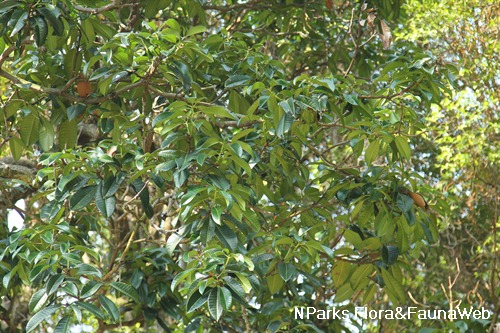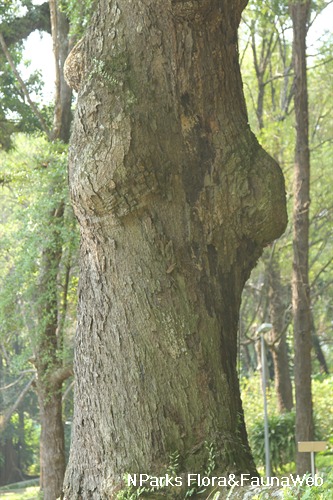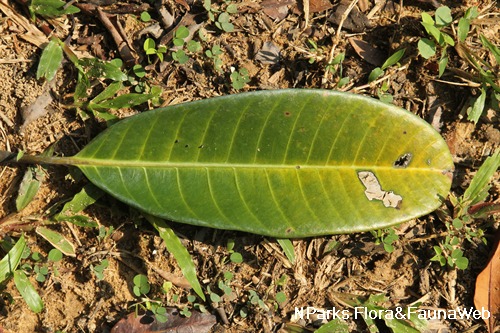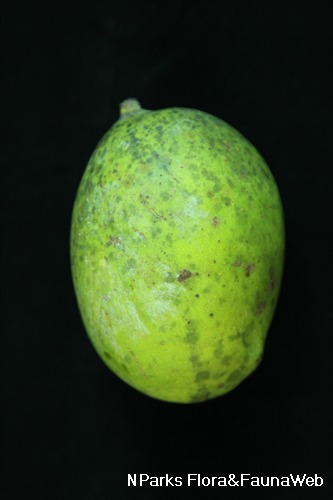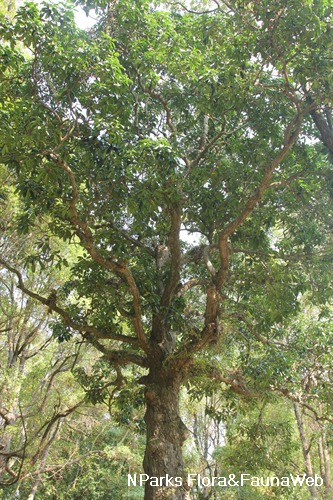
Name
Classifications and Characteristics
| Plant Division | Angiosperms (Flowering Seed Plants) |
|---|---|
| Plant Growth Form | Tree (Big (>30m)) |
| Lifespan (in Singapore) | Perennial |
| Mode of Nutrition | Autotrophic |
| Plant Shape | Irregular |
| Maximum Height | 40 m |
Biogeography
| Native Distribution | Peninsular Malaysia, Singapore, Sumatra, and Borneo. |
|---|---|
| Native Habitat | Terrestrial (Primary Rainforest) |
| Preferred Climate Zone | Tropical |
| Local Conservation Status | Native to Singapore (Critically Endangered (CR)) |
Description and Ethnobotany
| Growth Form | It is a large tree, up to 40 m tall, with a trunk about 1.3 m across. |
|---|---|
| Foliage | Its spirally arranged, stalked leaves appear pseudo-whorled at the end of twigs. Its thickly leathery leaf blades are oval to oblong, 13–18 by 5–9 cm, and have 15–17 pairs of lateral veins that are raised below. |
| Flowers | Its flowers are bisexual or male on the same plant, fragrant, and arranged in clusters at the end of branches or at the leaf axils. |
| Fruit | Its fruit is a drupe, ovoid to oblong, grey-green with brown spots, 9–12 by 8–10 cm, and has flesh white that is sweet to sour. |
| Habitat | It grows mostly in lowland and hill forests, up to 500 m altitude. |
| Associated Fauna | Its flowers are insect-pollinated. The fruits are probably eaten by large mammals. |
| Cultivation | It can be propagated by seed. |
| Etymology | Mangifera, mango-bearer, from the Hindu name, mangu, or Tamil, mankai, for the mango fruit, fero; Latin magnifica, magnificent, referring to the tree |
Landscaping Features
| Landscaping | It is suitable for planting in parks and large gardens. |
|---|---|
| Desirable Plant Features | Ornamental Form, Fragrant |
| Landscape Uses | General, Parks & Gardens |
Fauna, Pollination and Dispersal
| Pollination Method(s) | Biotic (Fauna) |
|---|---|
| Seed or Spore Dispersal | Biotic (Fauna) |
Plant Care and Propagation
| Light Preference | Full Sun, Semi-Shade |
|---|---|
| Water Preference | Moderate Water |
| Plant Growth Rate | Moderate |
| Rootzone Tolerance | Moist Soils, Well-Drained Soils, Fertile Loamy Soils |
| Propagation Method | Seed |
Foliar
| Foliage Retention | Evergreen |
|---|---|
| Mature Foliage Colour(s) | Green |
| Mature Foliage Texture(s) | Leathery, Thick |
| Foliar Type | Simple / Unifoliate |
| Foliar Arrangement Along Stem | Alternate |
| Foliar Attachment to Stem | Petiolate |
| Foliar Shape(s) | Non-Palm Foliage (Oval, Oblong) |
| Foliar Venation | Pinnate / Net |
| Foliar Margin | Entire |
Floral (Angiosperm)
| Flower & Plant Sexuality | Bisexual Flowers |
| Flower Grouping | Cluster / Inflorescence |
|---|---|
| Flower Location | Axillary, Terminal |
Fruit, Seed and Spore
| Mature Fruit Colour(s) | Green |
|---|---|
| Fruit Classification | Simple Fruit |
| Fruit Type | Fleshy Fruit , Non-Accessory Fruit |
Image Repository
Others
| Master ID | 31586 |
|---|---|
| Species ID | 5985 |
| Flora Disclaimer | The information in this website has been compiled from reliable sources, such as reference works on medicinal plants. It is not a substitute for medical advice or treatment and NParks does not purport to provide any medical advice. Readers should always consult his/her physician before using or consuming a plant for medicinal purposes. |

